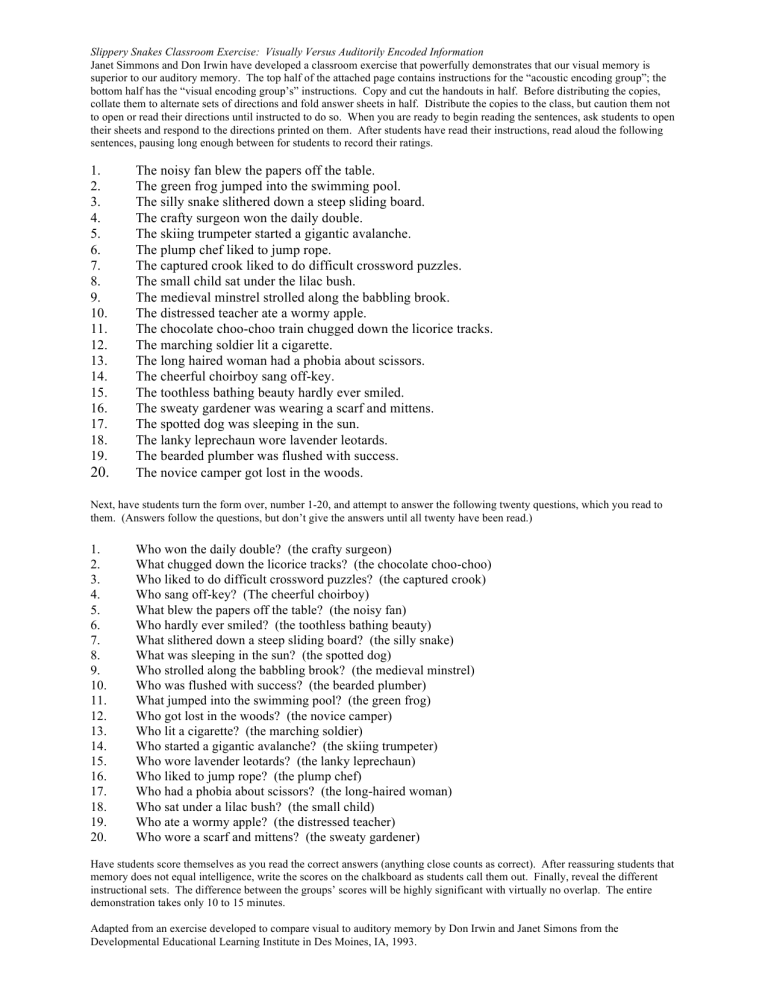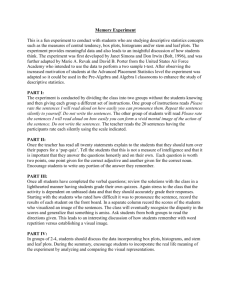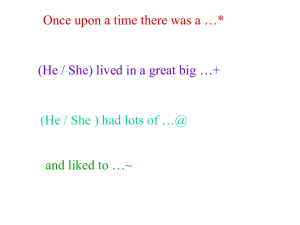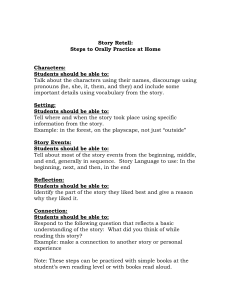
Slippery Snakes Classroom Exercise: Visually Versus Auditorily Encoded Information Janet Simmons and Don Irwin have developed a classroom exercise that powerfully demonstrates that our visual memory is superior to our auditory memory. The top half of the attached page contains instructions for the “acoustic encoding group”; the bottom half has the “visual encoding group’s” instructions. Copy and cut the handouts in half. Before distributing the copies, collate them to alternate sets of directions and fold answer sheets in half. Distribute the copies to the class, but caution them not to open or read their directions until instructed to do so. When you are ready to begin reading the sentences, ask students to open their sheets and respond to the directions printed on them. After students have read their instructions, read aloud the following sentences, pausing long enough between for students to record their ratings. 1. 2. 3. 4. 5. 6. 7. 8. 9. 10. 11. 12. 13. 14. 15. 16. 17. 18. 19. 20. The noisy fan blew the papers off the table. The green frog jumped into the swimming pool. The silly snake slithered down a steep sliding board. The crafty surgeon won the daily double. The skiing trumpeter started a gigantic avalanche. The plump chef liked to jump rope. The captured crook liked to do difficult crossword puzzles. The small child sat under the lilac bush. The medieval minstrel strolled along the babbling brook. The distressed teacher ate a wormy apple. The chocolate choo-choo train chugged down the licorice tracks. The marching soldier lit a cigarette. The long haired woman had a phobia about scissors. The cheerful choirboy sang off-key. The toothless bathing beauty hardly ever smiled. The sweaty gardener was wearing a scarf and mittens. The spotted dog was sleeping in the sun. The lanky leprechaun wore lavender leotards. The bearded plumber was flushed with success. The novice camper got lost in the woods. Next, have students turn the form over, number 1-20, and attempt to answer the following twenty questions, which you read to them. (Answers follow the questions, but don’t give the answers until all twenty have been read.) 1. 2. 3. 4. 5. 6. 7. 8. 9. 10. 11. 12. 13. 14. 15. 16. 17. 18. 19. 20. Who won the daily double? (the crafty surgeon) What chugged down the licorice tracks? (the chocolate choo-choo) Who liked to do difficult crossword puzzles? (the captured crook) Who sang off-key? (The cheerful choirboy) What blew the papers off the table? (the noisy fan) Who hardly ever smiled? (the toothless bathing beauty) What slithered down a steep sliding board? (the silly snake) What was sleeping in the sun? (the spotted dog) Who strolled along the babbling brook? (the medieval minstrel) Who was flushed with success? (the bearded plumber) What jumped into the swimming pool? (the green frog) Who got lost in the woods? (the novice camper) Who lit a cigarette? (the marching soldier) Who started a gigantic avalanche? (the skiing trumpeter) Who wore lavender leotards? (the lanky leprechaun) Who liked to jump rope? (the plump chef) Who had a phobia about scissors? (the long-haired woman) Who sat under a lilac bush? (the small child) Who ate a wormy apple? (the distressed teacher) Who wore a scarf and mittens? (the sweaty gardener) Have students score themselves as you read the correct answers (anything close counts as correct). After reassuring students that memory does not equal intelligence, write the scores on the chalkboard as students call them out. Finally, reveal the different instructional sets. The difference between the groups’ scores will be highly significant with virtually no overlap. The entire demonstration takes only 10 to 15 minutes. Adapted from an exercise developed to compare visual to auditory memory by Don Irwin and Janet Simons from the Developmental Educational Learning Institute in Des Moines, IA, 1993. Instructions: Please rate the sentence I will read aloud on how well you can form a vivid mental picture or image of the action of the sentence. Use the following scale: 1 Impossible to image 2 3 4 5 Very easy to image 1. 6. 11. 16. 2. 7. 12. 17. 3. 8. 13. 18. 4. 9. 14. 19. 5. 10. 15. 20. Instructions: Please rate the sentences I will read aloud on how easily you can pronounce them. Repeat the sentences silently to yourself. Use the following scale: 1 Very difficult to pronounce 2 3 4 5 Very easy to pronounce 1. 6. 11. 16. 2. 7. 12. 17. 3. 8. 13. 18. 4. 9. 14. 19. 5. 10. 15. 20.





